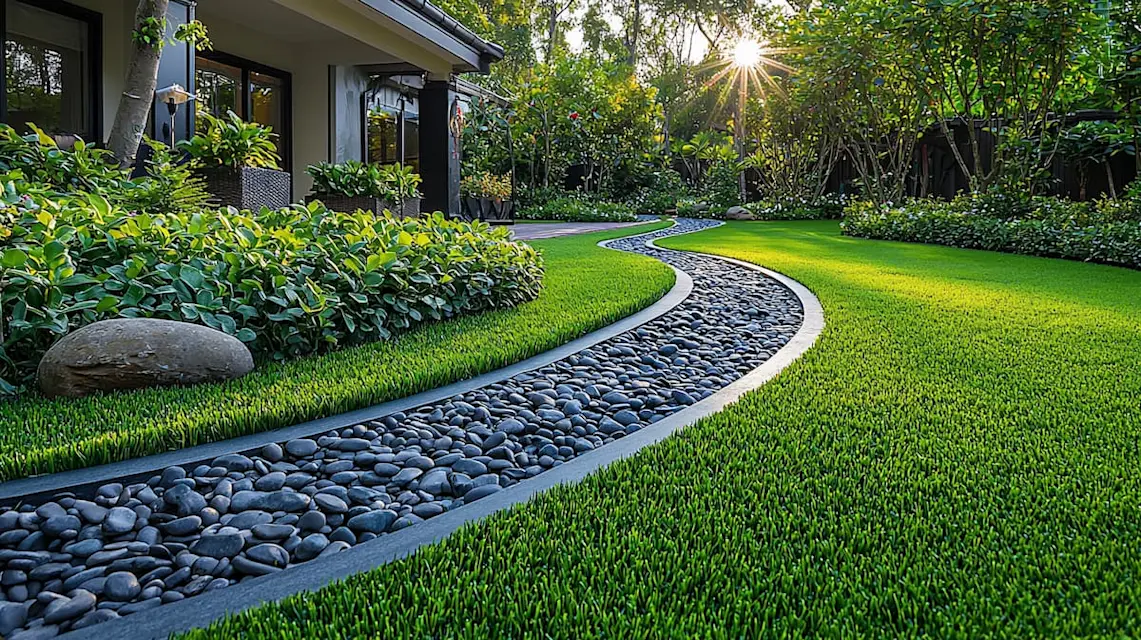
Click here to read the original article featuring Landscape Barn.
With climate change and natural disasters on the rise, landscaping design is emerging as an essential way to protect and mitigate against damage, especially against wildfire spread.
In the aftermath of the Los Angeles wildfires in early 2025, internet searches for fire resistant plants and fire resistant trees grew significantly. Homeowners are shifting to adopt proactive strategies with their landscaping designs, in addition to decorative and lifestyle considerations.
Most plants and structures will burn in the right conditions, but the goal is to create a landscape design that buys you time to stop the spread before it reaches your home. Firewise landscaping can be beautiful and protective at the same time. Here is how.
When creating your landscaping design, “Choosing the right trees and plants is just the first step. Where you place them matters just as much. Trees planted right against your home can be a major fire hazard in high-risk areas,” says Dominique Snyder district manager of Los Angeles Moon Valley Nurseries.
Phase your landscape plan into zones, with the immediate space (at least five feet) around your home clear from plantings. Plantings near the foundation can fuel flames to spread more quickly to threaten your home’s structure. This also provides enough space for firefighters to battle flames close to your home.
To fortify this zone, utilize hardscaping, which not only elevates the aesthetic in your yard, but stands up well to fire. “Stone doesn’t burn, or carry embers, and it provides a clean buffer between your home and anything in the yard that might catch fire. It is also extremely low maintenance,” says Christopher DeFeo owner/president at the Landscape Barn.
In the intermediate zone, which is typically between 5-30 feet away from the home, focus on fire breaks, such as driveways or walkways that can slow or stop flames approaching your home, states Snyder.
Throughout all zones, pay attention to tree placement. While grouping of trees is an aesthetic consideration in landscape design, and can help trees thrive, in fire-prone areas, it can be disastrous. The closer to the home, the farther apart the trees should be, so that fire can’t spread through canopy tops through to the house.
Decks, pergolas and other structures are sought after in outdoor design, but if materials are not chosen properly, they can be highly combustible. Opt for composite or concrete pavers for decking, and aluminum or composite for pergolas and shade structures. If using wood, apply a fire-resistant coating. For fences, consider fire-retardant coated material, or stone. Do not store anything under decks or porches, as that will add fuel to a fire, close to the home.
For outdoor kitchens and shade structures, install protective screens to prevent windborne embers from spreading.
Choose plants with high moisture content, watery sap, green growth, and little dead plant matter.
Low-maintenance, beautiful, and boosting sustainability, succulents are trending, and their high moisture content make them a good firewise planting. Boxwoods, hydrangeas, azaleas, and lilacs are good choices as well.
Mulch can ignite fires. It’s better to use inorganic, rock-based materials. If you are using bark, ensure it is well moistened.
"For shrubs and ground cover, consider trailing rosemary or myoporum. Not only do they help prevent erosion on hillsides, but they also resist fire and add a lush, green look to your yard," says Snyder.
"Deciduous trees naturally provide fire protection because they shed their leaves in the fall. Trees like the California Sycamore and Crepe Myrtle all offer this natural advantage,” Snyder says.
Avoid papery bark, plants with oily stems or gummy sap, such as conifers and evergreens.
Ongoing maintenance of your yard, including cutting grass, making sure lawns and plants are irrigated, trimming broken branches and removing debris regularly is an important part of protecting against wildfire. Overgrowth can accelerate wildfire growth Rake and bag leaves, as loose leaves can carry in the wind and exacerbate fire growth.
Take the guesswork out of your next project! Use our Project Calculator to quickly estimate the materials you need for your landscaping plans. Get started here with our Project Calculator.

We’re here to help you bring your outdoor vision to life—reach out with any questions or to start your next project.